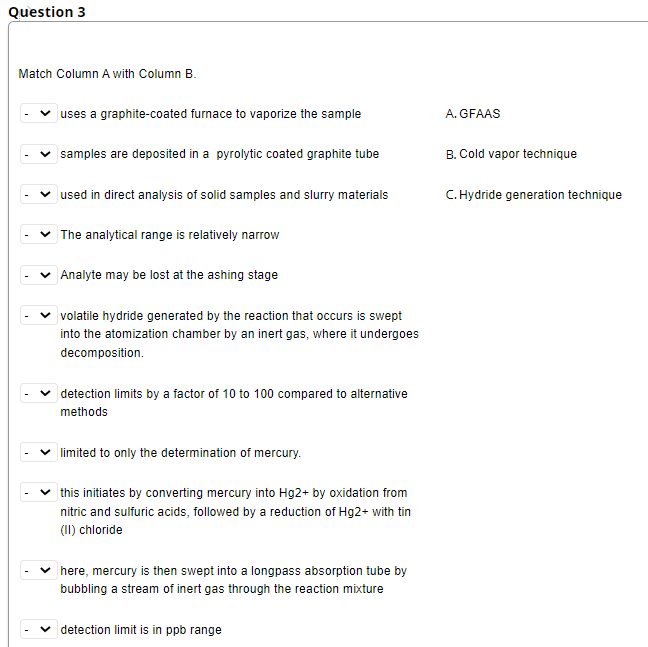Match Column A with Column B. uses a graphite-coated furnace to vaporize the sample A. GFAAS samples are deposited in a pyrolytic coated graphite tube B. Cold vapor technique used in direct analysis of solid samples and slurry materials C. Hydride generation technique
Match Column A with Column B. uses a graphite-coated furnace to vaporize the sample A. GFAAS samples are deposited in a pyrolytic coated graphite tube B. Cold vapor technique used in direct analysis of solid samples and slurry materials C. Hydride generation technique
Chapter22: Bulk Electrolysis: Electrogravimetry And Coulometry
Section: Chapter Questions
Problem 22.18QAP
Related questions
Question

Transcribed Image Text:Question 3
Match Column A with Column B.
uses a graphite-coated furnace to vaporize the sample
A. GFAAS
samples are deposited in a pyrolytic coated graphite tube
B. Cold vapor technique
used in direct analysis of solid samples and slurry materials
C. Hydride generation technique
The analytical range is relatively narrow
Analyte may be lost at the ashing stage
volatile hydride generated by the reaction that occurs is swept
into the atomization chamber by an inert gas, where it undergoes
decomposition.
detection limits by a factor of 10 to 100 compared to alternative
methods
v limited to only the determination of mercury.
|this initiates by converting mercury into Hg2+ by oxidation from
nitric and sulfuric acids, followed by a reduction of Hg2+ with tin
(II) chloride
here, mercury is then swept into a longpass absorption tube by
bubbling a stream of inert gas through the reaction mixture
detection limit is in ppb range
Expert Solution
This question has been solved!
Explore an expertly crafted, step-by-step solution for a thorough understanding of key concepts.
Step by step
Solved in 5 steps with 5 images

Knowledge Booster
Learn more about
Need a deep-dive on the concept behind this application? Look no further. Learn more about this topic, chemistry and related others by exploring similar questions and additional content below.Recommended textbooks for you

